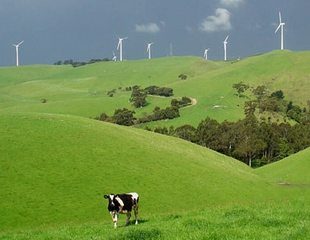With the Abbott government sabotaging Australia’s clean energy future, states such as Victoria must step up and lead on renewable energy.
The uncertainty unleashed by the Abbott government has cost Australia’s renewable energy sector dearly. On the Prime Minister’s watch, investment has collapsed by 90 per cent and over 2,500 people working in the sector have lost their job.
Not content with its savage 20% cut to the national Renewable Energy Target, the Abbott government has dictated to the Clean Energy Finance Corporation that it can no longer invest in wind farms and rooftop solar power.
This is the context in which the Daniel Andrews government is developing its Renewable Energy Action Plan to grow the sector and jobs in Victoria.

The Andrews government has been sending all the right signals when it comes to renewable energy. It was elected with a commitment to repeal the Baillieu-era restrictions on wind farms. And it delivered on the commitment just months after taking office.
To date, the Andrews government has provided financial support for the Newstead community in it pursuit to be 100 per cent renewable by 2017, as well as a 30-KW community solar project in Woodend. It has also established a $20 million New Energy Fund to encourage investment in renewable energy and cleantech projects.
The Andrews government’s Renewable Energy Action Plan is due for release later in 2015 and will build on these positive first steps.
“We will do whatever we need to do to increase the total percentage of energy generated from clean sources but also do whatever we can to create more jobs,” Premier Andrews said while visiting the Ararat wind farm.
There are some straightforward ways the Victorian government can increase renewables before it announces its comprehensive plan.
1. Renewable energy powered government
The Victorian government is a large purchaser of electricity. Putting a Power Purchase Agreement to tender could see it powered by renewable energy.
The collective demand for electricity from all those office buildings, schools, and hospitals, etc, could be enough to see a medium-sized wind farm built. And with over 2,000MW of wind farms already approved, there’s plenty of competition among developers to deliver the best value for the public.
All available public polling shows renewable energy is incredibly popular. The community would welcome a renewable energy-powered government.
2. Renewable energy powered public transport
Putting another spin on the government signing PPAs, Melbourne’s public transport system is another large user of electricity. So why don’t we power our trains and trams with clean renewable energy?
Documents obtained by Fairfax in 2014 found that Metro Trains was the state’s second largest carbon emitter. And the City of Melbourne says trams make up 10 percent of the city’s transport emissions. These statistics point to the sizable renewable energy projects that would be required for a zero-emission transport system.
A proposal for solar powered trams is already on the table.
3. Streamline wind farm planning
Victoria has a world-class wind resource and now has over 2,000MW of shovel-ready wind farms projects.
The state is competing against other jurisdictions for investment, so the time it takes to assess or amended a proposal in Victoria, South Australia, and New South Wales, will decide where investors put their money.
With some additional resourcing, Planning Minister Richard Wynn could streamline the planning process to make Victoria the place to invest.
4. Redirect fossil fuel subsidies to renewables and cleantech
The government could supercharge its New Energy Fund by redirecting fossil fuel subsidies to renewable energy and cleantech.
Both the Grattan Institute and Alternative Technology Association have criticised the $100 million Energy for the Regions spend on gas reticulation—a costly program the Andrews government inherited from its predecessor.
Redirecting these to advance the renewable energy and cleantech sector is smart economics and respects the growing sentiment in the community. Some 63 regional communities across the state have declared themselves unconventional gas and fracking free.
But that’s not all. According to The Australia Institute, in the six years from 2008-09 to 2013-14 the state government spent $205.7 million on subsidies to the minerals and fossil fuel sector.
Next steps…
These are just a few straightforward initiatives the Andrews government can implement to grow renewable energy in the short to medium term. They would build a strong foundation for its forthcoming Renewable Energy Action Plan.
Friends of the Earth have called for the state government to re-establish a Victorian Renewable Energy Target. Afterall, if we don’t know where we’re headed, then we’re unlikely to get there.
If Premier Daniel Andrews wants to make Victoria Australia’s renewable energy capital, then it can look to the ACT Labor government for inspiration.
It’s the ACT’s Renewable Energy Target of 90 per cent by 2020 that is building the Ararat and Coonooer Bridge wind farms in Victoria. (The investments have won the backing of state Liberal MP Louise Staley).
Restored certainty on the national Renewable Energy Target combined with the ACT’s wind energy auctions presents a winning formula for Victorian policymakers. A Victorian RET modeled on the ACT’s scheme can be a central plank of the Andrews government’s plan to grow renewables.
Will the Renewable Energy Action Plan contain a VRET? We’ll know by the end of the year.
Leigh Ewbank is Friends of the Earth Australia’s Yes 2 Renewables coordinator










